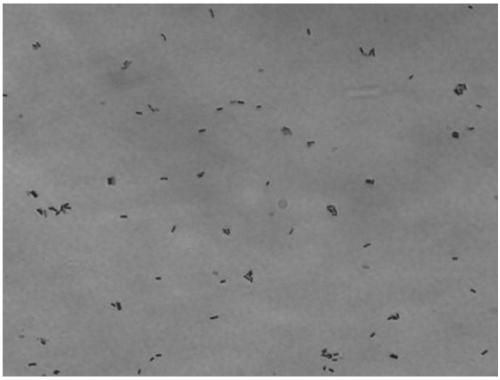Bacillus pumilus for feeds and application of bacillus pumilus
A technology of Bacillus pumilus and bacterial agents, applied in the field of microbiology and feed probiotics, can solve the problems of insufficient stability of live bacteria, less research and application, and inability to exist at the same time, so as to improve feed utilization and improve animal health. Effects of body weight and reduction of feed-to-meat ratio
- Summary
- Abstract
- Description
- Claims
- Application Information
AI Technical Summary
Problems solved by technology
Method used
Image
Examples
Embodiment 1
[0023] Example 1 Isolation and Identification of Bacillus pumilus 13824
[0024] 1. Isolation of strain 13824
[0025] 1. Isolation and cultivation of strains
[0026] Take 1g of the soil sample near the pig breeding base of the West Campus of China Agricultural University in Haidian District, Beijing, and put it into a test tube with 9ml of normal saline, vortex and shake it to make a 1:10 dilution, and then take the dilution to increase by 10 times Dilute, and then select 1ml of each of 3 appropriate gradient dilutions and spread them on the LB medium. Cultivate at 37°C for 48-72 hours, observe and record the colony shape, pick a single colony with good growth, and separate and purify by streaking.
[0027] 2. UV mutagenesis and screening of strains
[0028] Pour the sterilized LB medium into a petri dish, and after solidification, take the bacterial suspension obtained in step 1 and spread it on a plate. Control the number of colonies in each petri dish to about 50. 20c...
Embodiment 2
[0042] Example 2 Stress resistance detection of Bacillus pumilus 13824
[0043] 1. Heat resistance test
[0044] Put the Bacillus pumilus 13824 (CGMCC No.16539) bacterial solution in the water bath for 20 minutes, and treat it at 60°C, 80°C, and 100°C respectively, and repeat each treatment three times. After the treatment, use the pouring method to measure the number of viable bacteria .
[0045] The survival rate of Bacillus pumilus 13824CGMCC No.16539 can reach 99% after being treated at 60°C for 20 minutes, over 90% after being treated at 80°C for 20 minutes, and over 80% after being treated at 100°C for 20 minutes.
[0046] 2. Acid resistance test
[0047] Bacillus pumilus 13824 was inoculated into LB medium with pH values of 2.0, 3.0, 4.0, 5.0, and 6.0, respectively, and the number of viable bacteria was determined by plate pouring method at 1 h, 2 h, 3 h, and 4 h, respectively.
[0048] When the pH is 5.0 or 6.0 in a weakly acidic environment, Bacillus pumilus can ...
Embodiment 3
[0058] The growth curve determination of embodiment 3 bacillus pumilus 13824
[0059] The growth curve represents the dynamic changes in the whole process of bacteria growing and multiplying in a new suitable environment until aging and death. Bacillus pumilus 13824CGMCC No.16539 was inoculated into LB medium at an inoculum amount of 10% (v / v), and cultivated at 37°C for 46 hours. The LB medium without bacterial solution was used as a blank control, and every 2- Measure the OD600 value in 6 hours to calculate the number of viable bacteria. The experiment was repeated three times, the results were averaged, the data were recorded and the growth curve was drawn. Such as Figure 5 As shown, in 0-22 hours, Bacillus pumilus 13824 was in the logarithmic growth phase, and the reproduction rate was higher. The number of B. pumilus 13824 stabilized at 22-46 hours. After 46 hours, the growth rate decline phase was entered.
PUM
 Login to View More
Login to View More Abstract
Description
Claims
Application Information
 Login to View More
Login to View More - R&D
- Intellectual Property
- Life Sciences
- Materials
- Tech Scout
- Unparalleled Data Quality
- Higher Quality Content
- 60% Fewer Hallucinations
Browse by: Latest US Patents, China's latest patents, Technical Efficacy Thesaurus, Application Domain, Technology Topic, Popular Technical Reports.
© 2025 PatSnap. All rights reserved.Legal|Privacy policy|Modern Slavery Act Transparency Statement|Sitemap|About US| Contact US: help@patsnap.com



